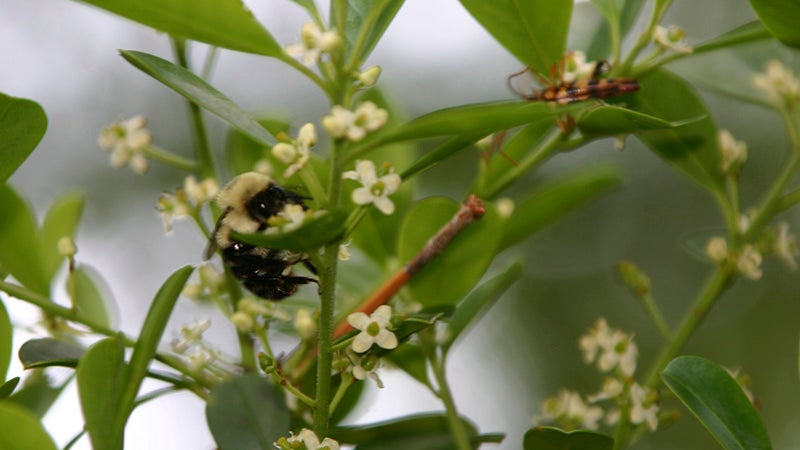Arboretum Paths: Plant a pollinator garden this spring
Published 7:00 am Wednesday, March 15, 2017

- ON THE HUNT: Although hollies have very inconspicuous, small flowers, pictured at top, they are a good source of nectar for foraging bees. Photo by Pat Drackett
By Pat Drackett, Director, The Crosby Arboretum
MSU Extension Service
Over the past month, it has been such a delight to see new growth emerging on the plants in the Arboretum’s Pollinator Garden. It won’t be long until they will be sporting blooms and attracting pollinating insects such as bees and butterflies, and maybe we’ll even be visited by a few hummingbirds!
The pollinator garden also includes several blueberry plants which were planted by the Pearl River County Master Gardeners. These shrubs offer an excellent source of early spring nectar to foraging bees, as do the native Elliot’s blueberries (Vaccinium elliotii) that are found along our woodland trails.
Last spring, our pollinator garden was completely rebuilt through a Pearl River County Partners in Leadership group project led by team members Michelle Berdux, Sharon Guepet, and Laurie Langlois, and volunteers. The team removed all of the existing materials, soil, and plants, and then planted a variety of perennials and annuals that were chosen to attract a wide array of pollinators.
Next time you enjoy a meal, be grateful for pollinators. Approximately three-fourths of the world’s crops depend on pollinators, such as birds, bats, and butterflies. However, bees are responsible for pollinating more plants than any other animal.
Over the last decade, native bee populations have been experiencing declines. If you are a gardener who has a favorite gardening publications or who enjoys surfing the Web for garden information, you’ve most likely come across articles focused on ways gardeners can help to boost bee populations by including certain plants in their home gardens to provide nectar sources.
One informative publication specific to Mississippi is available from the Extension Service, called, “Gardening for Beneficial Bees in Mississippi” (No. 2976). The document provides a wealth of information on how to design gardens that will attract these insects.
This publication is available to view or to download at https://extension.msstate.edu, and covers topics such as the times of the year when bee foraging is heaviest, why flower shape matters, tips on planting in masses and providing water and housing sources. Lists of plants that will attract bees are included in the publication.
Some of the native plant species that will grow well in our area and will attract pollinators include hollies, asters, coneflowers, Gaura, Liatris, Coreopsis, black-eyed Susan, Baptisia, Helianthus, buttonbush, passionflower vine, blueberries, hibiscus, Monarda, milkweed, and herbs such as basil, oregano, and rosemary.
Although gardeners often plant milkweed solely for the purpose of attracting monarch butterflies, the perennial also has a high value to pollinating insects. Last year, when we planted many groupings of butterfly weed (Asclepias tuberosa) into our pollinator garden, we were amazed by the high number of bumblebees that worked the flower clusters.
Would you like to learn more about the native pollinators found in coastal Mississippi, and how you can encourage them in your garden? Attend the program called “Attracting Native Pollinators” this Saturday, March 18, from 10:00 to 11:00 a.m. with Pearl River County Extension Agent Dr. Eddie Smith. Arboretum members attend free; cost for non-members is only $5. Please call the office at 601-799-2311 to reserve your seat.
Celebrate spring by planting a pollinator garden! Many plants that will attract bees, butterflies, and other pollinators can be found at our upcoming spring native plant sale, which is right around the corner on Friday and Saturday, March 24 and 25 from 10:00 a.m. to 3:00 p.m. each day. Admission to the Arboretum is free on plant sale days, so please make plans to come and enjoy an excellent opportunity to learn what we are all about.
Pearl River County Master Gardeners and Arboretum staff members will be at the spring plant sale to provide guidance in making selections that will best fit your property’s specific environmental conditions.
The Arboretum’s current gallery exhibit features nature photography by forest and wildlife biologist Robert Smith, who documents the Mississippi Gulf Coast’s flora, fauna, and habitats. Robert will be leading a nature photography workshop on May 6, and his exhibit will run through May 31.
For more information on visiting the Arboretum, or on upcoming programs and events, see www.crosbyarboretum.msstate.edu. Our public garden is located in Picayune, off I-59 Exit 4, at 370 Ridge Road, and is open Wednesdays through Sundays from 9 a.m. to 5 p.m.


